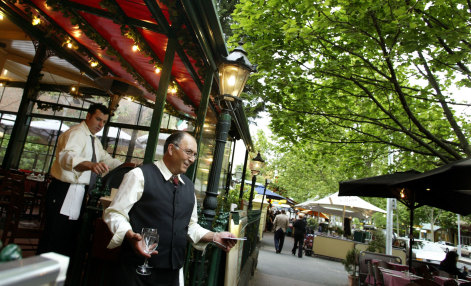This was published 1 year ago
How the shopping habits of Melburnians have changed
Specialty retail stores such as fashion, clothing, footwear and jewellery are bouncing back strongly from their COVID-19 blues, with the number of shops in the category surging across Melbourne’s suburban shopping strips over the past 12 months.
“Working from home has created a fundamental shift in Melburnians’ relationship with their shopping strips,” said Fitzroys division director James Lockwood. “We are spending more money closer to home and more time at our local villages than ever,” he said.

Lygon Street, Carlton, saw vacancy rates dip to 6 per cent, having surged to more than 20 per cent in the depths of COVID.Credit: Fairfax
The hyper-locality has offset some impact of a slump in consumer spending as high inflation and rising interest rates affect shoppers’ disposable incomes, he said. Retail turnover fell 0.8 percentage points in June, Australian Bureau of Statistics figures show, with falls in across all non-food industries.
The number of retail vacancies in shopping strips dipped 0.5 percentage points to 6.2 per cent in the year ended June 30, snapping back from their pandemic high of 10.3 per cent.
The latest Fitzroys’ 2023 edition of Walk the Strip report – an industry standard for assessing the health of suburban retail tenancies – shows that 72 per cent of strips saw an increase in specialty outlets, as vacancies dipped 1.5 percentage points below their long-term average of 7.7 per cent.
The number of fashion, clothing, footwear, bridal and jewellery tenants surged by 2.5 percentage points to 33.4 per cent of all tenants.
Service retail – including hair, nail and beauty salons, fitness studios and gyms, medical and allied health services – bounced back to 27.9 per cent of all strip shops. The category is now almost at the 28.9 per cent level achieved in the 2019 strip report, after they slumped to 26 per cent during the pandemic as shoppers baulked at close personal contact.
Through the year, household spending increased for services by 4.6 per cent, but fell for goods by 1.2 per cent, according to Australian Bureau of Statistics data for June.
Leasing activity among specialty retail tenants surged 2.5 percentage points to 33.4 per cent – almost equal to their 2019 and long-term average figures.
“Landlords are definitely meeting the market – they’ve been more open to transact, more willing to do a deal,” Lockwood said.
However, the amount of food and beverage shops dipped by 3.1 percentage points to 30.3 per cent, but they still remain above their long-term average.
Church Street in Brighton had the lowest strip vacancy rate in the city, at just 1.1 per cent. However, High Street, Armadale, is now challenging, with a number of high-end boutiques, specialty food offerings and new developments pushing vacancies down to 2.3 per cent.
Lygon Street, Carlton – one of the city’s most famous dining strips – saw vacancies dip to 6 per cent, having surged to more than 20 per cent in the depths of COVID.
The specialty retail rebound also saw Chapel Street, South Yarra, vacancies slide from 10.7 per cent to 7.9 per cent – the first time in years the precinct has recorded single-digit vacancies.
The worst performer was perennial struggler Bridge Road in Richmond – between Lennox and Church streets – which posted vacancies of 15.5 per cent, up from 11.7 per cent last year.
The Business Briefing newsletter delivers major stories, exclusive coverage and expert opinion. Sign up to get it every weekday morning.